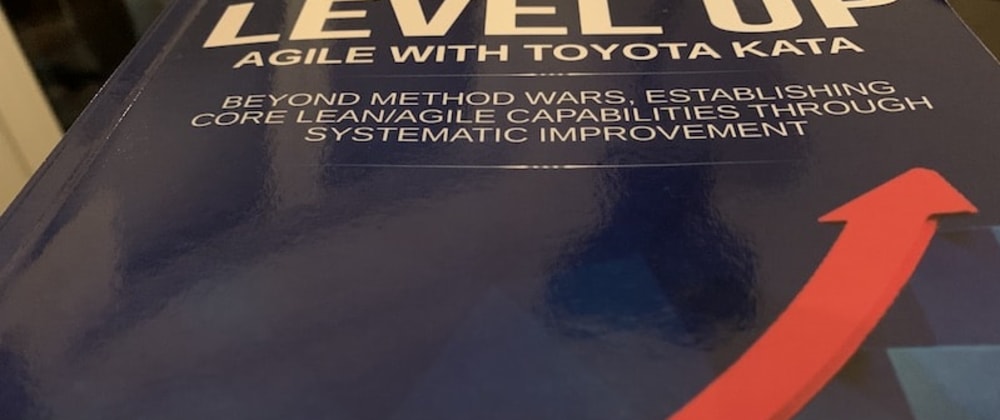Unable to make sense of the Toyota Kata Practice Guide book, I decided to pick up Jesper Boeg's Level Up Agile with Toyota Kata.
Jesper makes Toyota Kata more relatable to IT and it accommodates for the differences between manufacturing and software development.
As a big plus, it contains 80 pages with examples. A great resource for understanding and getting started.
If you are looking for a more structured explanation of how to apply Toyota Kata read Continuous improvement with Toyota Kata
Key Insights
- Toyota Kata is a process improvement process:
- 10-20% time on improvement work.
- Applied at the team level:
- End-to-end cross functional teams.
- Stable teams are essential.
- It is expected that you will change it as you get familiar with it.
- Does not replace retrospectives.
- Learning is maximized when there is a 50/50 chance of failure (REINERSTEN, 2009).
- Process improvement is the primary reason the manager role exists.
- Vision:
- Focus on what you want, not in what you dont want.
- Process Vision != Process outcome.
- Tool, role and practice free.
- Choose metrics that can be measured frequently:
- Allow for more experiments.
- Culture of continuous improvements.
- Be conscious of the time spent automating them.
- We tend to drastically overestimate the number of problem that stand in the way of our goals.
- Do not recommend including Time as an Obstacle.
- Biggest risk in product development is delivering value-adding features and products.
- "If the learner did not learn, the teacher did not teach".
- A Mural example (read only)
- A Mural template (requires Mural account):
 Improvement Kata Template by MURAL
Improvement Kata Template by MURAL

Open to create a mural from this template in your workspace. Powered by MURAL
TOC
- Part 1: Toyota Kata Basics
- Part 2: The Starter Kata. Roles, Events and Concepts.
- Part 3 - Toyota Kata in the wider organization
- Part 4 - Using Other Models with Toyota Kata
Part 1: Toyota Kata Basics
2 - Why do we need Toyota Kata?
- When in your improvement work:
- You focus on the easy changes, not most important.
- Not look at the effects of improvements.
- Managers not focused on driving improvements.
- Daily work is always more important than improvement work.
- Improvements lacking direction.
- Too much improvement work in progress.
- Improvement slow and often on hold.
- Teams improvements always require escalation.
4 - Introducing the Toyota Kata framework
- Starter Kata = Improvement Kata + Coaching Kata.
- Future state:
- Vision: True North, years in the future.
- Challenge: ambitious goal aligned with the Vision.
- Target Condition:
- short term ambitious goal.
- First step towards Challenge.
- Both Challenge and Target Condition: measurable and grounded in firm understanding of Current Condition.
- Improvement Kata, steps:
- Understand Vision and set Challenge.
- Gasp Current Condition.
- Decide on Target Condition.
- Experiment towards Target Condition.
- Learning is maximized when there is a 50/50 chance of failure (REINERSTEN, 2009).
- Coaching Kata:
- Coaching dialogue to improve the learner's ability to execute the Improvement Kata.
- An opportunity to learn.
- Toyota Kata: at the team level (expected end-to-end cross functional teams).
5 - Toyota Kata events and cadences in an Agile context.
- Cadence:
- Challenge: 2-6 months.
- Target Condition: 4 weeks. 90 min meeting.
- Coaching Kata: 1-2 times per week. 15 mins.
- Daily Team Kata: 1-5 mins.
- 10-20% time on improvement.
Part 2: The Starter Kata. Roles, Events and Concepts.
- Starter Kata is just to start. It is expected that you will change it as you get familiar with it.
7 - Toyota Kata Roles
- Process Lead:
- Has the last call on the process improvement process.
- Choose Challenge and Target Condition.
- Investigate and describe Current Condition.
- Participate in Coaching Kata.
- Update Improvement Board.
- Visualize progress and trends on Current Condition metrics.
- Facilitate Improvement Kata Planning meetings.
- Facilitate Daily Kata.
- Challenge the team and organization to set ambitions improvement goals.
- Marketing and selling to the team
- Stable teams are essential.
- Process Lead =~ Scrum Master.
- Process improvement is the primary reason the manager role exists.
- Managers should have their own Challenges and Target Conditions.
8 - Toyota Kata Events
- Coaching Kata:
- To grow the skills of the Learner.
- Learner must come prepared: all data gathered.
- 5 questions + 1 extra:
- What is the Target Condition?
- What is the Current Condition now?
- Reflect on the last step:
- What was your experiment?
- What did you expect?
- What actually happened?
- What did you learn?
- What Obstacles you think are preventing you from reaching the Target Condition?
- Which one are you addressing now?
- What is your next experiment?
- What do you expect will happen?
- When can we evaluate the result?
- What did you learn from this Coaching Kata?
- Sometimes the Coach will decide on the next step to get to the next learning point.
- Planning coaching cycles:
- Similar to the "refinement" process for agile teams.
- Start two weeks before the next Improvement Kata Planning meeting.
- Add questions regarding the Challenge and next Target Condition to the Coaching Kata.
- Daily Team Kata:
- Focus on experiment record.
- Every day:
- Plan: process improvement to be the smallest step possible.
- Do: hold everybody accountable.
- Check: What has been learn?
- Adjust (act): Reflect on learning.
- Improvement Kata Planning meeting:
- Focus on setting the Target Condition, not on defining overall direction.
- Bring data of Current Condition.
- Challenge is also ready.
- Coach present.
- Pitfalls:
- Discussing Target Condition for the whole 90 mins.
- Not everybody will always agree.
- Identifying all obstacles and future ones.
- Perfect metrics instead of good enough.
- Discussing Target Condition for the whole 90 mins.
- Individuals will have to put the teams interests over their own.
- Default meeting agenda:
- Did we achieve our last Target Condition?
- If not, why? What happened? What did we learn?
- What is the Challenge?
- What is our Current Condition?
- Review the updated Value Stream Map.
- What is the proposed focus area for the next four weeks?
- Agree on the next focus area.
- Identify the Target and Current Condition for the chosen focus area (iterative).
- Identify Obstacles.
- Find Experiment ideas and choose the first Experiment.
- Did we achieve our last Target Condition?
- Not a replacement for Agile Retrospectives (<- short term fixes).
9 - Vision
- Focus on what you want, not in what you dont want.
- Process Vision != Process outcome.
- Tool, role and practice free.
- Agile Vision:
- Strategy alignment:
- People can identify with the overall success and how is aligned with the strategic direction.
- Funding is transparent, dynamic, outcome focused and based on unbiased financial modeling.
- Empowered, self-organizing teams.
- Stable end-to-end teams with 100% allocation.
- Entire Value Stream within a single team.
- Always releasable.
- Small batches, always outside-in approach:
- Each work item includes a hypothesis of the actual monetary value.
- Visual management - full transparency.
- Continuous customer and end-user feedback.
- Developers have access to real users.
- One by one flow.
- Strategy alignment:
10 - The Challenge
- Step towards vision.
- Desirable Future State: Not a problem.
- Towards a goal, not away from problems.
- "Wouldn't it be great if we could ...?"
- Metrics:
- "From X to Y "
- X is Current Condition.
- Y is Future State.
- From 4 Disciplines of execution
- Both Outcome (lagging) and Process (Leading) metrics.
- "From X to Y "
- No implementation details, no solutions.
- Risk: measuring Current Condition without affecting it.
- 20/80 rule.
- Historical data.
- Realistic and ambitious.
- Choose metrics that can be measured frequently:
- Allow for more experiments.
- Culture of continuous improvements.
11 - Target and Current Condition
- Target Condition focus on a subset of the Challenge.
- Fill first:
- Process metrics.
- Qualitative Outcome.
- Outcome metrics:
- Can be difficult, and it is ok if we cannot measure them. Replace it for an Outcome theme.
- Data accuracy: 80% benefit with 20% effort.
- Remember that the Target Condition will change, hence metrics collected are temporal.
- Be conscious of the time spent automating them.
- If the Target Condition is overambitious:
- Cut scope.
- Abort "sprint".
- If unambitious: Increase scope.
- It is ok to have a "learning" Target Condition but should be a rare thing.
12 - Obstacles
- Not solutions framed negatively.
- We tend to drastically overestimate the number of problem that stand in the way of our goals.
- No need to fix all obstacles to reach the Target Condition.
- Do not recommend including Time as an Obstacle.
-
Cynefin:
- CLEAR:
- Known knows.
- Clear cause and effect.
- Sense, categorize, use best practice.
- COMPLICATED:
- Known unknowns.
- There is a cause and effect, but need expertise.
- Range of right answers.
- Sense, analyze, choose good practice.
- COMPLEX:
- Unknowns unknowns.
- Cause and effect can only be decided in retrospect.
- Probe (safely), sense, emergent practice.
- CHAOTIC:
- Unclear cause and effect.
- Act (to stablish order), sense (where stability is), novel practice.
- CLEAR:
13 - Experiments and Experiment Records (PDCA)
- When coaching ask if removing the obstacle or if a successful experiment will move us closer to the Target Condition.
- Experiment idea: just one liner.
- Experiment record:
- Choose Obstacle.
- Choose experiment idea, and add:
- Post-it with:
- What we will do.
- When it will happen.
- Who is responsible.
- Post-it with:
- Expectation if success.
- When to validate the result.
- Post-it with:
- Just one experiment at a time, except:
- You can clearly separate the results.
- Low effort, high calendar time.
- May need to repeat an experiment several times to confirm it removes an obstacle in a sustainable way.
- Make experiments small:
- Dont need to solve the whole Obstacle.
- 50% should take less than 3 days.
- Record and celebrate success:
- Success cards (page 147).
15 - Dashboard
Mural Toyota Kata Dashboard:
 Improvement Kata Template by MURAL
Improvement Kata Template by MURAL

Open to create a mural from this template in your workspace. Powered by MURAL
Part 3 - Toyota Kata in the wider organization
16 - The coach, the learner and the second coach
- "If the learner did not learn, the teacher did not teach".
- Usually the manager is the coach.
- Second coach: coach the coach, but also learn from the coach.
17 - Catch-balls, Challenges and Target Conditions at the manager level.
- Slower cadence of Kata events. Recommendations in page 173.
- Catch-balls:
- Organization level improvements that tickle down the org.
18 - Roll-out of Kata in the organization
- Ignore Outcome metrics for the first Challenge.
19 - The true potential of Toyota Kata
Skipped.
20 - Scaling Agile with Toyota Kata
Skipped.
Part 4 - Using Other Models with Toyota Kata
- Value stream mapping is great to understand Current Condition.
- Avoid Future State Value Stream mapping.
- Toyota Kata can move you beyond "Proto-Kanban".
- Toyota Kata maybe has potential for product development.
- Biggest risk in product development is delivering value-adding features and products.







Top comments (0)